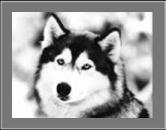|



|
|
Description: |
The Alaskan Malamute
is a large, strong dog, originating from North America (Alaska),
descended from the Arctic wolf. Its name originated from
Mahlemuts, an Alaskan tribe that raised and cared for these
dogs. Originally used 3000 years ago by these Mahlemuit Eskimos
of Alaska, they pulled light travelling sleds and also heavy
loads.The Malamute is a sled dog and has participated in many
polar expeditions. It has a thick, coarse outer coat and a
greasy and woolly undercoat with a plumed tail held over the
back.
|
|
Size: |
Dogs Height: 24-26
inches (61-66 cm.)
Weight 80-95pounds
(36-43 kg.)
Bitches Height 22-24
inches (56-61 cm.)
Weight 70-85 pounds
(32-38 kg.)
|
|
Coat: |
The Alaskan Malamute
has a dense coat which should be brushed twice a week. This
breed sheds very heavily with the undercoat coming out in clumps
twice a year. Bathing is not necessary as the coat sheds dirt
naturally. An occasional dry shampoo should suffice. The coat
averages one to three inches in length and comes in white, black
& white, wolf gray, wolf sable (red undercoat with dark gray
outer coat), or red, often with darker highlights and sometimes
with a dark mask or cap. The legs and muzzle are almost always
white.
|
|
Ease of Training: |
Even though this dog
has a friendly nature, it still requires firm training ideally
from a handler who has plenty of confidence.
|
|
Temperament: |
The Alaskan Malamute
is loyal, intelligent, sweet and affectionate and is great with
older children. As they are friendly with everyone, they are not
normally used as guard dogs. If the dogs do not receive enough
attention they may become bored and destructive. Malamutes love
outdoor activities and can perform well in obedience tasks with
the correct training. Quiet in comparison to most dogs,
Malamutes will howl. Malamutes have a strong prey instinct and
should be supervised around unfamiliar small animals. Firm
handling and training are necessary. Proper socialization with
people and other dogs is important. Obedience training is highly
recommended.
|
|
Exercise: |
Malamutes need a
significant amount of exercise, ideally at least an hour a day
of hard exercise.
|
|
Health Problems:
|
The Alaskan Malamute
is generally a very hardy breed. They are prone to hip dysplasia,
but no more than any other large breed and less then many
others. Some are prone to chondrodysplasia, which is dwarfism.
Some clubs require OFA, CERF, and CHD (dwarfism test)
certification of both parents. Prone to bloat.
|
|
Life Expectancy: |
About 12-15 years.
|
|

|